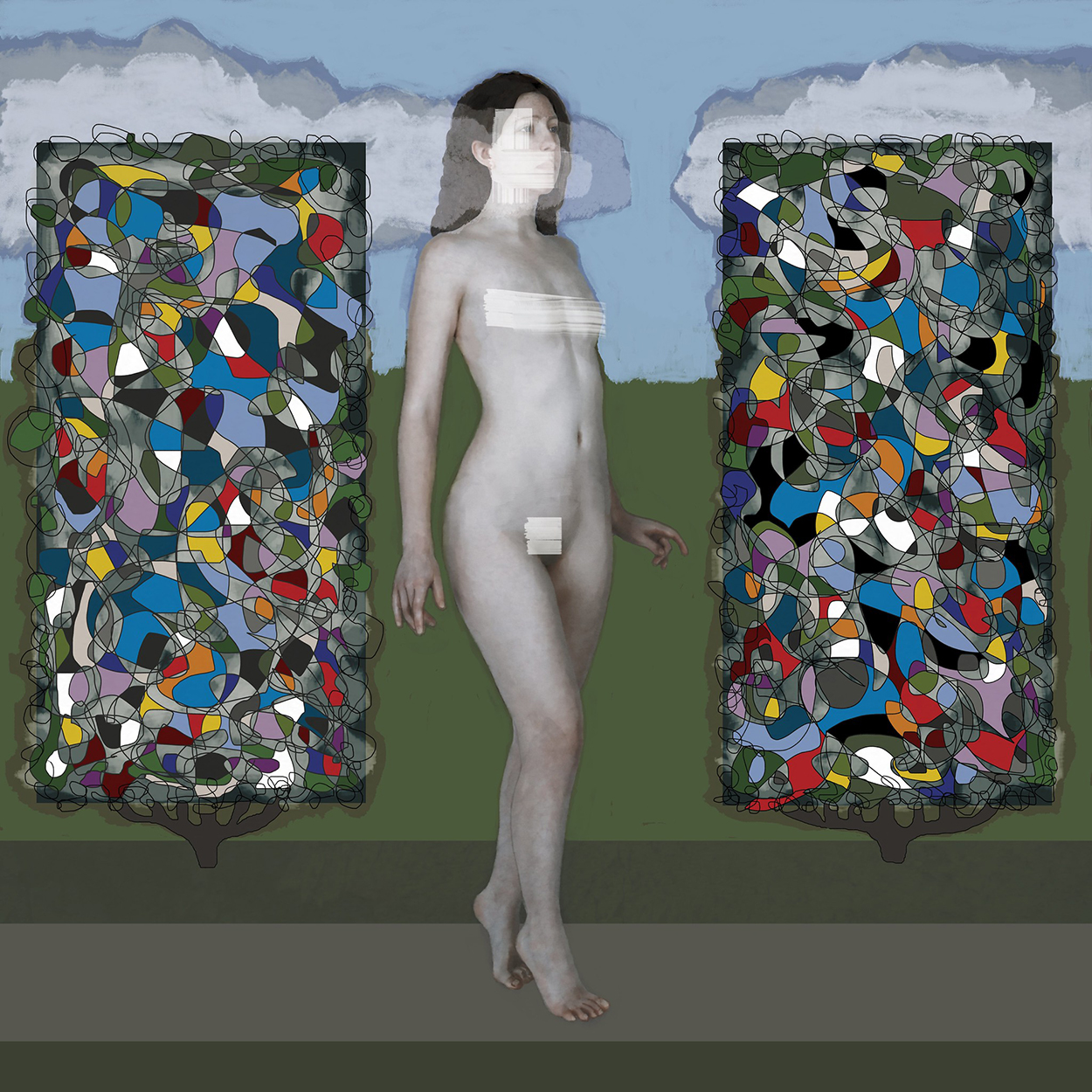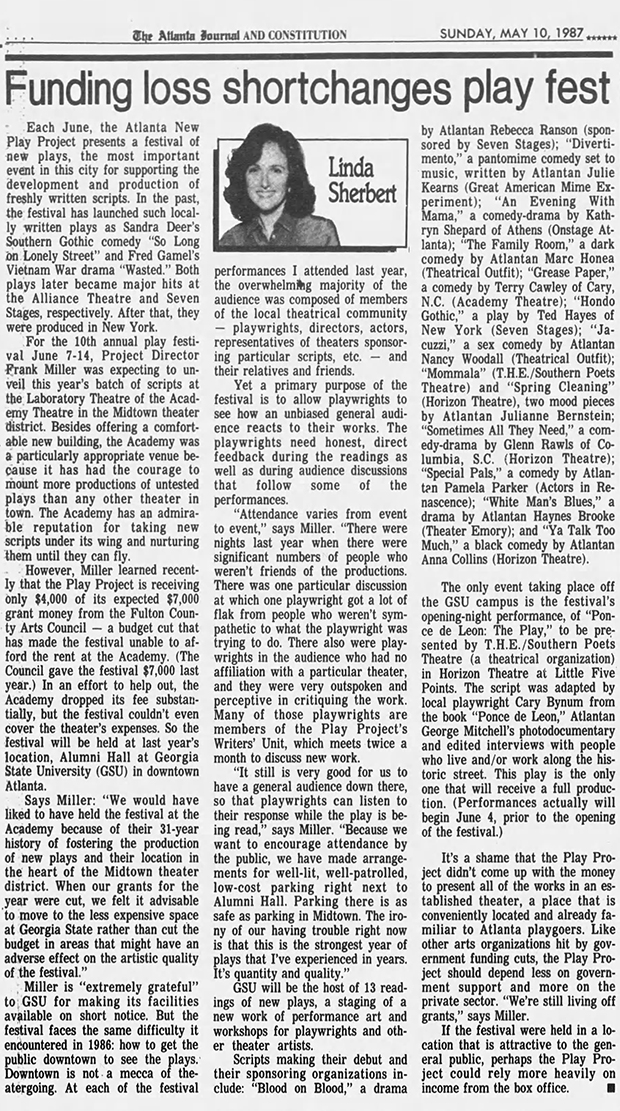
Above image: A Divertimento -- Rococo Ghosts of Glass Slippers, 2018. Digital art by Juli Kearns
Header image: Televised Dinner Theater of Mortals and Gods Featuring Janus, 2015, by Juli Kearns
DIVERTIMENTO
by Juli Kearns
A play with no dialogue in 8 scenes
Director: Sandra Hughes
Movement Coach: Michael E. Hickey
THE ENSMBLE
Cynthia Evans
Lee Fuettere
Michael E. Hickey
David Hughes
Charles Lewis
Jean O'Hearn
Presented by G.A.M.E., the Great American Mime Experiment, in a workshop production at the June 1988 Atlanta New Play Project
Oddly (I think), people used to be baffled by the prospect of a play with no dialogue. Which was DIVERTIMENTO. The above art has nothing to do with the play, and yet does, I made it to commemorate DIVERTIMENTO though with a sensibility of rococo forced into the abstract through a grinding mill. There was a caged bird in the play, as well a man with a bird cage on his head, and somewhere in those twin hedges are little birds, some caged, some free. DIVERTIMENTO was inspired by opera, silent film, and surrealism, and only found a place in my imagination through my association with the Great American Mime Experiment (G.A.M.E.), who were doing surrealist work and would be putting on my play, THE ONION OPERETTA, which also had no dialogue, in 1988. After the rigorous use of language in EYE OF THE MATADOR, I wanted no language at all but for what was supplied by movement, props, staging and music. After heavy, morbid, mysterious myth, I wanted...a divertimento.
Never mind the grotesque aspect of the decadent display of wealth among the elite in 17th and 18th century France, I wanted something of the careless froth of Jean-Honoré Fragonard's painting "The Swing", in which a wildly dense yet highly cultivated arbor provides cover for the antics of courtly romance. Dressed in voluminous puffery, a woman whose flesh is as sunrise pink as her eye-grabbing, iridescent gown, is caught by the painter at the apex of her flight on a swing. If one gazes upon her long enough, evaluating the misty ray of light that focuses upon her alone in the dark of the woods, her inexplicable radiance, she may become as immortal Venus disguised as a cloud brightened by Apollo, further camouflaged as this woman of the court. In the dark behind her, barely glimpsed, is an older man who guides the ropes of her swing, presumably her lover, or a hopeful one (he was supposed to be a Bishop). From his side, behind the woman, a stone putti looks on with alarm. While before the woman, hidden down in a tumult of shrubbery, we see a man ecstatically gazing up her petticoat as she swings one leg high so that a shoe soars off toward another putti who plants a finger over his lips begging silent discretion. It's said that Gabriel Francois Doyen was first requested to do the painting, and he refused because it was frivolous, but Fragonard certainly recalled Doyen's "Le Sacrifice d'Iphigenie" in "The Swing", how Iphigenie rises on clouds of smoke from the sacrificial fire into a heavenly light that breaks through a large tree behind the pyre. Iphigenie is even in a seated posture on the smoke, one leg raised higher than the other, so the girl on the swing mimics her pose. Below, a soldier gazes up, arm upraised in awe at the vision of Iphigenia being received by a goddess.
Above: Fragonard's "The Swing". Below: Doyen's "Le Sacrifice d'Iphigenie"
Wikipedia relates, "This style of 'frivolous' painting soon became the target of the philosophers of the Enlightenment, who demanded a more serious art which would show the nobility of man...The original owner remains unclear. A firm provenance begins only with the tax farmer Marie-François Ménage de Pressigny, who was guillotined in 1794, after which it was seized by the revolutionary government."
While "The Swing" is frivolous, it is also, in its most luminous version, exquisite, a dream. It reminds of one of those myths in which a mortal happens upon a nude goddess and is struck blind. Silence! Reveal not what you have seen, which must be discovered by everyone individually! Sometimes the frivolous offers a door to deeper realms. And "The Swing" ends up being a richer, more enduring painting than Doyens' "Le Sacrifice d'Iphigenie" by virtue of its sense mystery, unanswered questions, and our not knowing its story..
In a bit of wry humor, there was a swing formed of two men in DIVERTIMENTO. There was thievery and luminous jewels and doubles and romance and deceit. It was cynical, though not mean-spirited, and earnest, and a parody of absurd intrigues that occupied the court before the guillotine came crashing down. Madame du Barry and her peers had a thing for children and cupids in art mimicking the lives of adults, and there were a couple of children who made an appearance in the script who played at being adult (but then it could seem the adults played at being adult). Every movement, down to the second, was choreographed to music.
Scene 1: Brahm's Variations on a Theme by Haydn
Scene 2: Telemann, Fantasia No. 11 in B-flat major; and Fantasia No. 12 in E-falt major
Scene 3: Anton Webern's Orchestration of the Fugue from The Musical Offering of Bach (without Opus)
Scene 4: Schubert-Webern, German Dances for Orchestra
Scene 5: Satie, the first of "Troi Gnossiennes"
Scene 6: Bach, Musical offering, Ricercare a 3
Scene 7: Satie, the first two waltzes from "Les Trois Valses du Precieus degoute"
Scene 8: Rameau, Nais, Overture
The work was a demanding one, envisioned exactly, down to the second, I was at the rehearsals, which were demanding, which were fun because it was just plain fun, and the actors did beautifully, they were wholly invested, and now I can't begin to imagine how it was accomplished. It had a full workshop production, with props, and bits and pieces of costuming, no sets, Sandra Hughes directing, Michael Hickey the movement coach, and as I recollect it was a success, at least with the actors. It was beautiful, comedic, silly, foolish, serious, devious, observant, blind, self-absorbed, effervescent, surreal, and ultimately breathless. I don't recollect the audience response at all because I was as breathless as the actors when it was finished.
It was wonderful to do a staging that was just plain fun.
The money for the Atlanta New Play Project had been slashed that year, as the below article reveals.
I don't find in the AJC an article that checked back in on the festival to review what was done.
I think Lisa Patorino, as listed in the program, may instead be Lisa Pastorino. A Lisa Pastorino was, in1988, also in the movie Stars and Bars which was filmed in Georgia, so I'm pretty sure that must be her.
There was a moderated discussion after the workshop production of the play. I attended, but didn't participate actively, and remember nothing about it other than being there and watching others speak to others.
Uploaded March of 2022. 1100 words approx. 2 pages of text

Closing Image: Televised Dinner Theater of Mortals and Gods, Satyr, 2015, by Juli Kearns




